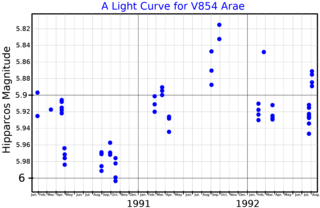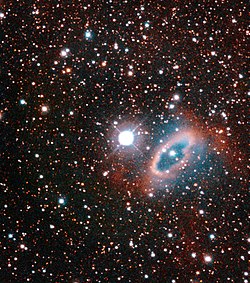HD 102776, also known by its Bayer designation j Centauri, is a suspected astrometric binary star system in the southern constellation of Centaurus. It has a blue-white hue and is faintly visible to the naked eye with a typical apparent visual magnitude of 4.30. The distance to this star is approximately 600 light years based on parallax, and it is drifting further away with a radial velocity of ~29 km/s. It is a member of the Lower Centaurus Crux subgroup of the Sco OB2 association. HD 102776 has a relatively large peculiar velocity of 31.1 km/s and is a candidate runaway star that was ejected from its association, most likely by a supernova explosion.
K Centauri is a possible binary star in the southern constellation of Centaurus. It has a white hue and is bright enough to be visible to the naked eye, having an apparent visual magnitude of +5.04.

HD 155035 is the Henry Draper Catalogue designation for a star in the constellation Ara, the Altar. It is located at a distance of approximately 1,450 light-years from Earth and has an apparent visual magnitude of 5.92, making it is faintly visible to the naked eye. This is a red giant star with a stellar classification of M1.5 III. It an irregular variable that changes brightness over an amplitude range of 0.12 magnitudes.

HD 93194 is a star in the constellation Carina. Its apparent magnitude is 4.79. Its parent cluster is IC 2602.
HD 102350 is a single star in the constellation Centaurus. It has a yellow hue and is visible to the naked eye with an apparent visual magnitude of 4.11. The distance to this star is approximately 390 light years based on parallax, but it is drifting closer with a radial velocity of −3 km/s. It has an absolute magnitude of −1.51.

Sigma Ophiuchi, Latinized from σ Ophiuchi, is a single, orange-hued star in the equatorial constellation Ophiuchus. Its apparent visual magnitude is 4.31, which is bright enough to be faintly visible to the naked eye. The annual parallax shift of 3.62 mas as seen from Earth provides a distance estimate of roughly 900 light years. It is moving closer to the Sun with a radial velocity of −28 km/s.
HD 63399 is an orange hued star located in the southern constellation Puppis, the poop deck. It has an apparent magnitude of 6.45, placing it near the limit for naked eye visibility. Based on parallax measurements from Gaia DR3, the object is estimated to be 445 light years distant. It appears to be receding with a spectroscopic radial velocity of 28.5 km/s. At its current distance, HD 63399 is diminished by 0.29 magnitudes due to interstellar dust.
HD 39901 is an orange hued star located in the constellation Columba. It is also called HR 2069, which is the star's Bright Star Catalog designation. Eggen (1989) lists it as a member of the old disk population.

MZ Puppis is a red supergiant star in the constellation of Puppis. It has a radius of 400 R☉.
HD 83058 is a subgiant star in the constellation Vela and a spectroscopic binary. It is visible to the naked eye with an apparent visual magnitude of 5.0. Based upon an annual parallax shift of 3.4254 mas, it is located 950 light-years from the Sun. The system is moving further away with a heliocentric radial velocity of +35 km/s.
HD 76270, also known as HR 3544, is a solitary, white hued star located in the southern circumpolar constellation Volans. It has an apparent magnitude of 6.10, making it faintly visible to the naked eye if viewed under ideal conditions. The object is relatively far with a distance of 2,360 light years, but is slowly approaching the Solar System with a heliocentric radial velocity of −2.6 km/s.
HD 50002 is a solitary star in the southern circumpolar constellation Volans. It is faintly visible to the naked eye with an apparent magnitude of 6.09 and is located at a distance of 708 light years. However, it is drifting further with a heliocentric radial velocity of 5.1 km/s.
HD 30080, also known as HR 1509, is a solitary, orange hued star located in the southern constellation Caelum, the chisel. It has an apparent magnitude of 5.66, allowing it to be faintly visible to the naked eye. Parallax measurements from Gaia DR3 place the object at a distance of 612 light years. It appears to be approaching the Solar System with a heliocentric radial velocity of −3.8 km/s. Eggen (1989) lists it as a member of the thick disk population.
HD 75116, also known as HR 3491, is a solitary, orange hued star in the southern circumpolar constellation Volans, the flying fish. It has an apparent magnitude of 6.31, placing it near the limit for naked eye visibility. Parallax measurements from the Gaia spacecraft place the star relatively far at a distance of 930 light years. It appears to be approaching the Solar System, having a heliocentric radial velocity of −17.5 km/s.
HD 200044 is a solitary star in the equatorial constellation Delphinus. It has an apparent magnitude of 5.7, allowing it to be faintly seen with the naked eye. The object is located 598 light years away, but is approaching the Solar System with a heliocentric radial velocity of −15.07 km/s.
HD 222806 is a suspected astrometric binary in the southern circumpolar constellation Octans. It has an apparent magnitude of 5.74, allowing it to be faintly seen with the naked eye. Parallax measurements place the system at a distance of 565 light years and it is currently receding with a heliocentric radial velocity of 21 km/s.

HD 174387 is a solitary star in the southern constellation Telescopium. With an apparent magnitude of 5.49, it is faintly visible to the naked eye if viewed under dark skies. Parallax measurements put the object at a distance of 810 light years and it is currently approaching the Solar System with a heliocentric radial velocity of −28.1 km/s.
HD 193721 is an astrometric binary in the southern circumpolar constellation Octans. It has an apparent magnitude of 5.77, allowing it to be faintly seen with the naked eye. Parallax measurements place the system 760 light years away from the Solar System and it is currently receding with a heliocentric radial velocity 8.6 km/s.
HD 194612 is a solitary orange hued star located in the southern circumpolar constellation Octans. It has an apparent magnitude of 5.9, making it visible to the naked eye under ideal conditions. Parallax measurements place it at a distance of 760 light years and it has a low heliocentric radial velocity of 0.3 km/s.
HD 33519, also known as HR 1682, is a probable spectroscopic binary located in the southern circumpolar constellation Mensa. It is one of the stars near the limit of naked eye visibility, having an apparent magnitude of 6.28. The system is relatively far at a distance of 940 light years but is approaching with a heliocentric radial velocity of −2.5 km/s. However, this value is poorly constrained.





